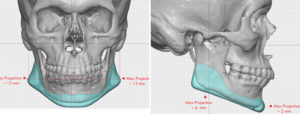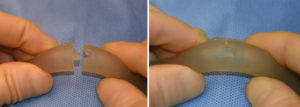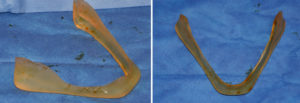Background: Augmentation of the total lower third of the face is historically and most commonly done using standard implants. The combination of chin and jaw angle implants, a three implant approach, provides enhancement of the three corners of the lower face. While theoretically appealing and a good solution for many jawline needs, it can be unsuccessful for a variety of reasons. These include implant asymmetry, the inability of standard implants to provide the desired aesthetic result and the lack of connection between all three implants.
A custom jawline implant connects the chin and jaw angle regions in either a linear or non-linear fashion.The size or thickness of the connection between the chin and jaw angles of the implant determines whether there is a smooth or linear look going from the chin back to the jaw angles or whether the chin and jaw angles stand out more than what connects between them. (non-linear look)
Designing a custom jawline implant with existing indwelling implants is ‘easier’ and more helpful than if no implants were there at all. Knowing what the aesthetic effects of existing implants creates, even if undesired, helps guide a new implant design that may produce a better result. While the custom implant design process is greater from the standpoint of fit to the bone, symmetry of both sides of the implant and creating a unified look, the computer or surgeon has no way of knowing exactly what implant dimensions can exactly achieve the patient’s goals.




Highlights:
1) Jawline augmentation by three separate preformed implants often does produce a satisfactory or desired shape of the lower third of the face.
2) With existing chin and jaw angle implants in place, a custom jawline implant can be designed for an improved facial outcome.
3) Contrary to popular perception, Medpor implants can be successfully removed although it is more traumatic to the tissues than that of silicone implant removal.
Dr. Barry Eppley
Indianapolis, Indiana




